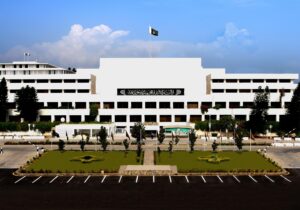Pakistan Election Aftermath: Coalition Government, Economic Challenges, And The Struggle For Substantive Solutions
No Comments yet
The Parliament House ~ Islamabad
02-19-2024 ~ Pakistan’s recent elections led to a PML-N and PPP coalition, overshadowed by economic challenges and a focus on personalities. However, the overarching question persists: can these parties provide a substantial alternative for the people?
On February 8, 2024, Pakistan conducted its parliamentary elections with 44 political parties contesting for 265 seats in the National Assembly. This marked the 12th general election in the country since it gained independence 76 years ago.
After the announcement of results on February 11, the Pakistan Muslim League-Nawaz (PML-N), under the leadership of Nawaz Sharif, and the Pakistan People’s Party (PPP), led by Bilawal Bhutto-Zardari, joined hands to form a government. Both of these parties were not able to reach the majority mark. Nawaz Sharif put forth his younger brother, Shehbaz Sharif, as the nominee for the position of Prime Minister.
Parties and Regional Results
Pakistan’s National Assembly comprises 336 seats, and elections were conducted for 265 seats. The election for one seat was postponed after the death of a candidate, while the remaining seats (60 for women and 10 for minorities) were reserved for members of those groups and allocated based on the proportional representation of parties in the election results.
According to the Election Commission of Pakistan, the independents supported by now-jailed Imran Khan’s party Pakistan Tehreek-e-Insaf (PTI) secured 93 seats in the National Assembly . Pakistan Muslim League (Nawaz), headed by former Prime Minister Nawaz Sharif, attained 75 seats. The Pakistan People’s Party led by former Foreign Minister Bilawal Bhutto Zardari obtained 54 seats. The Muttahida Qaumi Movement (MQM), a party based in Karachi, made a noteworthy comeback, winning 17 seats in the polls, and has pledged full support to PML-N. The remaining 26 seats were secured by others.
In the provincial elections, candidates from PML (N) won 138 seats in Punjab while independents backed by PTI won 116 seats. Additionally, the PPP secured 10 seats and later offered support to Nawaz Sharif’s party. PTI-backed candidates won a majority in Khyber Pakhtunkhwa, securing 84 seats out of 113. In Sindh, the PPP obtained a majority by winning 83 seats out of 130, while Balochistan voted in a hung assembly.
Maryam Nawaz, the daughter of Nawaz Sharif, made history by being the first woman to be nominated as the Chief Minister of Punjab province in Pakistan.
What Led to PTI’s Revival?
These elections occurred against a backdrop of broad public dissatisfaction directed at the previous government headed by the PML (N) and PPP. The discontent stemmed from their inability to control the prices of essential commodities and address the economic challenges faced by the majority of Pakistanis.
Furthermore, the arrest of Imran Khan, his involvement in multiple legal cases , the prison sentences he received, and his party losing its election symbol added to the prevailing chaos. Nevertheless, the public perceived the targeting of Imran as an assault on democracy, mobilizing support and playing a significant role in the PTI’s performance. Pakistanis expressed dissatisfaction with the military’s role in politics, seeking change and a genuine democratic system. Imran Khan emerged as the preferred candidate to fulfill these aspirations.
Issues in the Election
In Pakistan, a primary concern for voters centered around the burning issue of inflation, a critical factor that has significantly eroded real wages. A real wage is the income that an individual receives for their work, adjusted for inflation. The average real wage has seen a substantial decline in Pakistan, plummeting by 13 percent in the year 2023 alone, increasing financial strain on the people.
The industrial sector of the country is in a downturn, with the high costs of inputs acting as a major barrier. The manufacturing output of large industries witnessed a staggering 15 percent year-on-year contraction in June 2023, due to the high cost of doing business. Moreover, the broader economic scenario from July 2022 through June 2023 indicates an overall industrial decline of 10.26 percent, pointing towards the intensity of the challenges faced by the manufacturing sector.
The imposition of stringent austerity measures mandated by the International Monetary Fund (IMF) and the transition toward market-based prices have further constricted Pakistan’s capacity to navigate economic challenges effectively. This shift in economic policy has not only impacted the purchasing power of citizens but has also intensified the economic hardships faced by businesses, particularly in the manufacturing domain which is the highest creator of employment opportunities.
Adding to the complexity is the absence of a comprehensive plan for reindustrialization, leaving the economy without a clear roadmap to revitalize its industrial base. The allocation of a substantial portion of the budget, approximately $17 billion , to subsidies that primarily benefit a privileged elite increases the economic disparities within the country. Concurrently, the persistently high unemployment rate, currently standing at 8 percent, underlines the challenges faced by ordinary people.
Collectively, these issues underscored the intricate economic landscape in Pakistan, where concerns about inflation, industrial decline, austerity measures, and the distribution of resources played pivotal roles in shaping voters’ perspectives and influencing their choices.
However, a notable positive outcome from the recent elections is the limited influence of religious parties, with their representation remaining below 10 seats. This suggests a preference among voters for a more secular and inclusive political landscape, emphasizing national interests over religious affiliations.
The recently held Pakistan election, considered one of its most significant, experienced a substantial voter turnout despite lingering doubts about its fairness. Before the polls, concerns were raised regarding the fairness of the Election Commission, which denied PTI its symbol and the consistent ‘persecution’ of Imran Khan. Several petitions challenged constituency results post-general elections, citing issues with Forms 45 and 47, crucial in Pakistan’s electoral process. Form 45, recording votes at polling stations, includes vital details submitted to the Returning Officer for final results. Form 47 offers a provisional overview before official confirmation, consolidating Form 45 data. PTI raised concerns over their polling agents not being provided Form 45 and significant discrepancies between Form 47 results and detailed Form 45 information in several cases.
The appeals for unity from both political and military figures underscore the strained civil-military relationship. Unfortunately, none of the political parties presented a substantive alternative agenda. Critical issues have taken a back seat in the discussions. Instead, the focus had shifted disproportionately toward the personalities of Imran Khan and Nawaz Sharif, turning the entire electoral narrative into a contest of charisma.
Asif Ali Zardari is poised for a potential second term as president. Imran Khan has cautioned against the “misadventure” of establishing a government based on “stolen votes,” asserting that such electoral manipulation would not only disrespect citizens but also worsen the country’s economic decline.
Uncertainties persist regarding tangible benefits for the people, including increased income for farmers and workers as promised, the prevention of government overthrow by the military, and potential surprises from Imran Khan. Amidst numerous questions, answers remain elusive, leaving the population to confront challenges while elites build their castles.
By Pranjal Pandey
Author Bio: This article was produced by Globetrotter.
Pranjal Pandey, a journalist and editor located in Delhi, has edited seven books covering a range of issues available at LeftWord. You can explore his journalistic contributions on NewsClick.in.
Source: Globetrotter
You May Also Like
Comments
Leave a Reply







